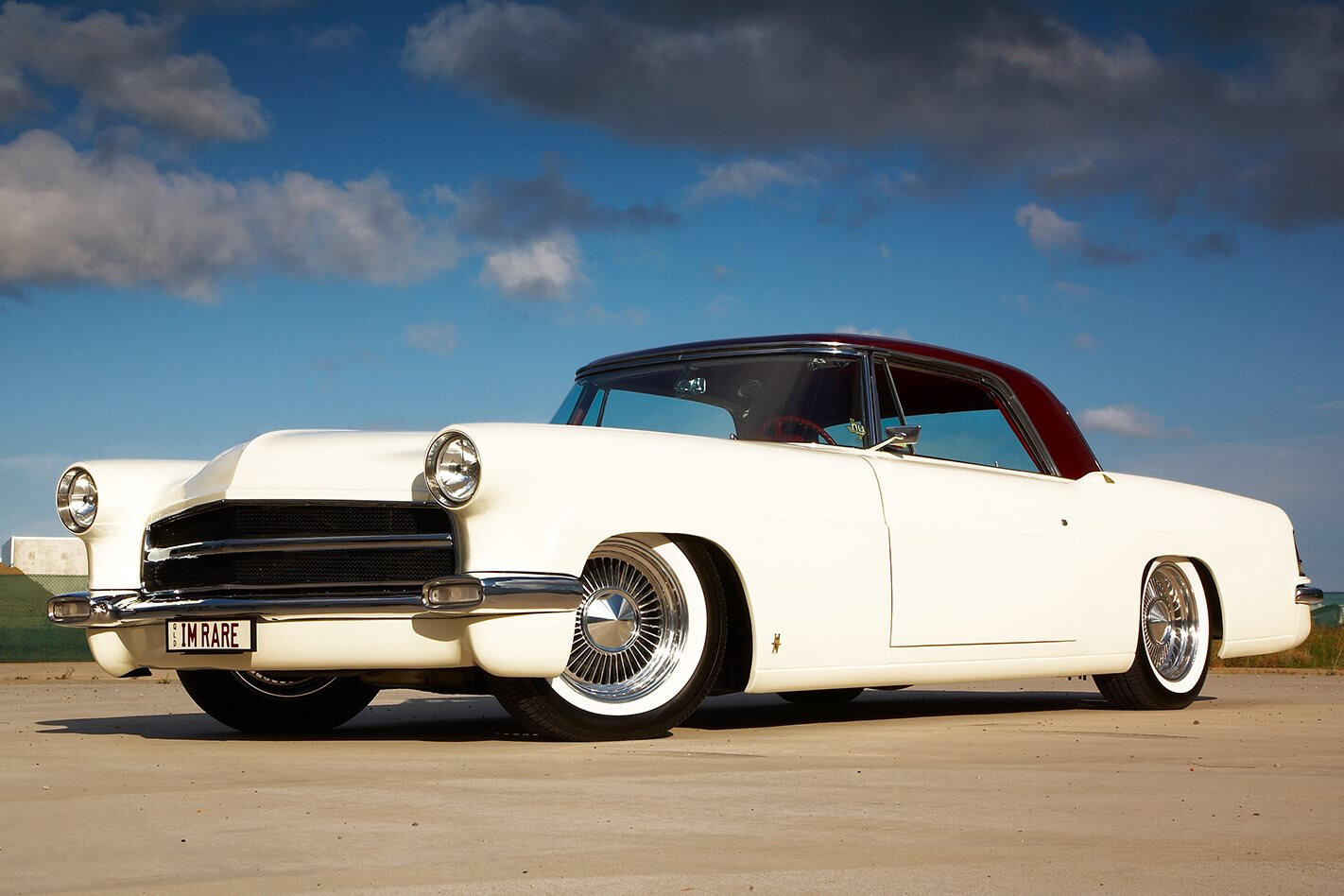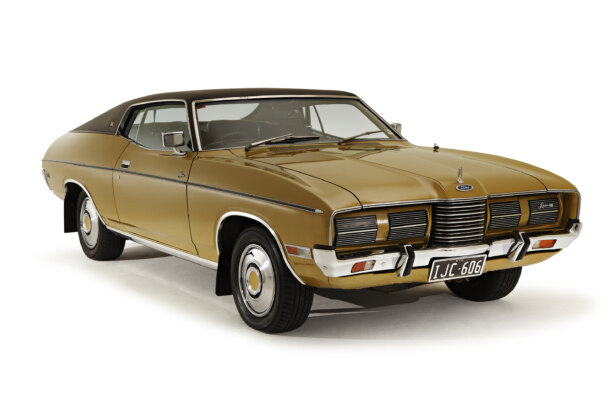This article on John Cook’s Lincoln was originally published in the March 2008 issue of Street Machine magazine
IT TAKES a very special person to modify a car as rare and desirable as a 1956 Continental Mark II. These babies cost around $10,000 when new, which was around twice the price of the most expensive Cadillac or equal to a Rolls-Royce. But what makes it really crazy is that Ford used such high-quality materials in these cars, it lost about $1000 on every one sold!
Only 3000 or so were built during the two-year – 1956–7 – production run and thanks to the dreaded tinworm, the number still in existence is considerably lower than that.
John Cook, the owner of this pristine example, explains why: “The Mark II is bad for rust because everything is double-skinned and you can’t get at anything to repair it. Add to that the sound-deadener between the panels and if they’re left out in the weather, they just rot. I reckon there’s only about 500 or so left, and that’s everything from perfect cars to absolute shitters.”
Thankfully, the example John found after months of late nights on the internet was just about perfect.
Styled around the factory hub caps, the wheels are actually 17-inch billets designed and built by Ian Splatt at Dragway, to John’s design. Don’t go looking for a set, they’re one-offs
“The original owner had it until 1990, then the second owner gave it a resto when he bought it. It wasn’t great, but it was okay. The motor was completely rebuilt to stock specs and since that time has only done about 3500 miles, and I haven’t touched it. He assured me no expense was spared, and so far it seems fine,” explains John.
John admits he was pretty lucky and managed to find a really good car but it’s pretty obvious he had done his homework before committing to buy a car from halfway around the world, sight unseen.
John went to a lot of trouble to shave the door handles and build the flush-fitting buttons. He also liked the trapdoor key-lock, so decided to keep it
“It cost me $500 to get two independent inspections. I figured it was better to spend that than 30 grand on a car that turned out to be no good. The detail that you get back is unbelievable and when it arrived it was exactly as the report stated, right down to the last nut and bolt. They even went back and double-checked things – because I knew how bad they were for rust, I really wanted to make sure there were no surprises,” John says.
All that extra work paid off as the only rust in the entire car was a small area in the boot floor where the air conditioning unit sits – a common spot for rust in the Mark IIs.
The restoration back in 1990 had included a bit of a jam job: “It was a pretty crappy paint job, riddled with humidity blisters. There wasn’t a single spot on the body where it hadn’t been affected,” John says.
John’s a pretty handy bloke – a painter and plasterer by trade – and he usually paints his own cars but leaves the bodywork to someone else. He figured with the Mark II he would take on the whole job himself.
“When I stripped the paint back, it was amazing. The bodies are works of art when you get them back to bare metal. The only damage I found was on the right-hand rear quarter panel where it had obviously taken a knock and been repaired at some stage,” says John.
Most people wouldn’t have the guts or even feel the need to modify a car that was practically a custom when it left the factory, but John seriously considered chopping the roof. Turns out even he has limits, though.
“I’m as hot rod as they come and I’ll chop anything but I just couldn’t do it on this car. The lines are so nice, simple and elegant that I didn’t think it needed it. If you look at it in profile, it looks like it’s sectioned anyway,” he says.
Unique to ’56 models with a/c, these vents aren’t just for show – they direct fresh air to the condenser
Although that roof didn’t get a haircut, a host of subtle touches clean up the lines considerably – John has followed the mantra of all the great customisers and improved the flow of the car, rather than modifying for the sake of it.
It has all the classic tricks: frenched headlights, shaved handles and badges, nosed and decked and a custom grille.
Motor is a bog-stock 368ci Lincoln, although it looks pretty cool thanks to its Continental-only alloy rocker covers and those exhausts that exit through the fender wells
“I only kept one badge on the car and that’s because it reminded me of those classic custom shop crests of the 50s, like Barris, and that’s the badge just behind the front wheel,” explains John. Sometimes it’s what you leave on that can make all the difference.
Take the bumpers for instance. One common customising trick in the 50s was to run bumpers from a different car, such as Cadillac, Buick or Chevy on Mercurys, or to flip the bumpers upside-down for a different look. But those sleek units on John’s Mark II are actually bog-stock standard.
It might look like a custom trim job but that’s exactly how they were made. The seats were retrimmed in 1990 and John replaced the carpet but the rest is as it left the factory in 1956
“The bumpers are in two pieces and held together by about 4000 bolts – it’s ridiculous! I had the top half of each bumper rechromed, then I stripped and painted the lower halves.” The effect was much thinner and more elegant-looking bumpers.
He ended up using three bumpers on this car. Apologies to any Mark II restorers out there looking for a bumper, but the extra one was cut up to make that simple, and very cool, grille bar.
“I really don’t like the stock grille and wanted to do something with it but I just couldn’t figure out how to make a bar that curved in two directions. Then I noticed that the top section of the bumper would be perfect for the job. It took another four or five months but I found a bumper on eBay, in New York. I only paid US$190 for it.”
John then enlisted the help of Shaun Phillips and together they spent about 50 hours creating that rather simple-looking grille bar.
“The bumpers are made of high-tensile steel and are very hard to cut. I really wanted to make sure we didn’t stuff it up because we only had the one bumper!”
John had already created a grille insert in polished stainless steel to mount the grille bar. “I had it all ready to go and when I put the grille bar on it didn’t look right, so it’s now got a polished stainless insert that’s been powder-coated black!” he laughs.
With all the bodywork done, it was time to tackle the paint – something most customisers are pretty confident of doing better than the factory. When it came to the Continental Mark II, it’s a different story. These cars were wet-sanded and baked between primer and surface coats, before having two coats of lacquer applied. They were then oil-sanded and baked before another two coats of lacquer were laid on and baked, then hand-buffed and polished to perfection. Sounds more like something out of a high-end custom shop than off a production line!
Vents in the roof are for a/c – there are another two in the front to make sure everyone stays cool. The vents are fed air from the boot-mounted a/c unit via pressed-cardboard ducting between the roof and the headlining
When it came time to choose a colour, John was pretty sure of what he wanted: “I’ve looked at all the colours but to me, they never look better than when they’re white. I made up a custom mix that’s actually a really pale green when you compare it to straight white,” John says. “The car was going to be all white but I started to wonder what it would look like with a candy roof. I had the paint because I’d used it on a bike years back. It’s House of Kolor Goldmine Pearl with Brandy Wine Kandy over the top.” I’m pretty sure the guys at the factory would be pretty happy with the job John did, even though it wasn’t offered as an option in 1956.
It’s just enough to let you know that there’s something going on with this car and it draws you in for a closer look, to check out all the other neat details. The problem is, once you start checking it out, you’re likely to be stuck there a while. It’s unlikely you’ll see another; not in Australia anyway.
“Supposedly there’s another one around Sydney somewhere,” John muses. “A black one. But no one’s ever seen it. I think it’s one of those urban myths.”
JOHN COOK
1956 CONTINENTAL MARK II
Colour: Custom white, HoK Goldmine Pearl/Brandy Wine Kandy
ENGINE
Type: Lincoln 368ci
Induction: Holley four-barrel
Crank: Standard, balanced
Exhaust: Dual 2½in
Dyno figures: 285hp @ 4600rpm; 402lb-ft @ 3000rpm
TRANSMISSION
Gearbox: Lincoln three-speed auto
Diff: Lincoln Power Lok, 3.07:1
SUSPENSION & BRAKES
Springs: Lowered 2½in (f), lowered 3in (r)
Steering: Power assisted
Brakes: Vacuum assisted 12in Lincoln drums (f & r)
WHEELS & TYRES
Tyres: Diamond Back 225/55 (f & r)
Wheels: Dragway custom billets 17×7½ (f & r)




Comments